SkatterBencher #58: AMD Ryzen 9 7900X3D Overclocked to 5789 MHz
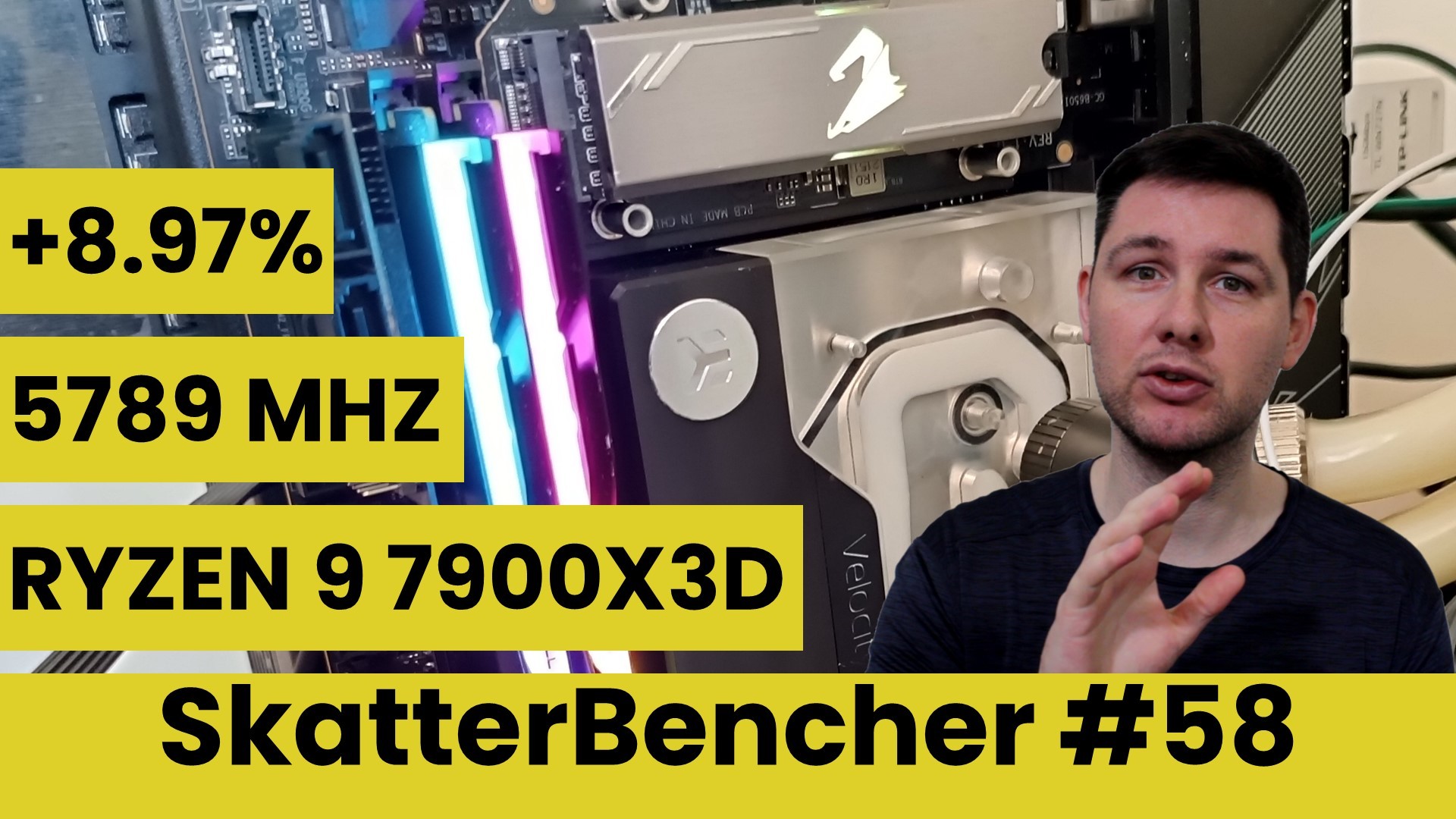
We overclock the AMD Ryzen 9 7900X3D up to 5789 MHz with the GIGABYTE B650I Aorus Ultra motherboard and EK-Quantum water cooling.
I picked this motherboard to check the X3D overclocking experience on a more mainstream offering. Also, I really like compact mini ITX solutions. Unlike the first-gen Ryzen X3D, the 7000X3D series are unlocked for overclocking. However, that doesn’t mean it’s easy to overclock.
All right, we have lots to cover, so let’s jump straight in.
AMD Ryzen 9 7900X3D: Introduction
The AMD Ryzen 9 7900X3D processor is part of the third wave of Ryzen 7000 Zen 4 AM5 desktop processors.
The first wave of Zen 4 Ryzen 7000 processors launched on August 29, 2022, and consisted of 4 X-SKUs ranging from the 6-core Ryzen 5 7600X to the 16-core Ryzen 9 7950X. The second wave of Ryzen 7000 processors launched on January 4, 2023. It consisted of 3 non-X SKUs ranging from the 6-core Ryzen 5 7600 to the 12-core Ryzen 9 7900. The third wave of Ryzen 7000 processors, announced on January 4 but only available since February 28, consists of exclusively X3D variants with 3D-V-Cache. The line-up consists of 3 SKUs ranging from the 8-core Ryzen 7 7800X3D to the 16-core Ryzen 9 7950X3D.
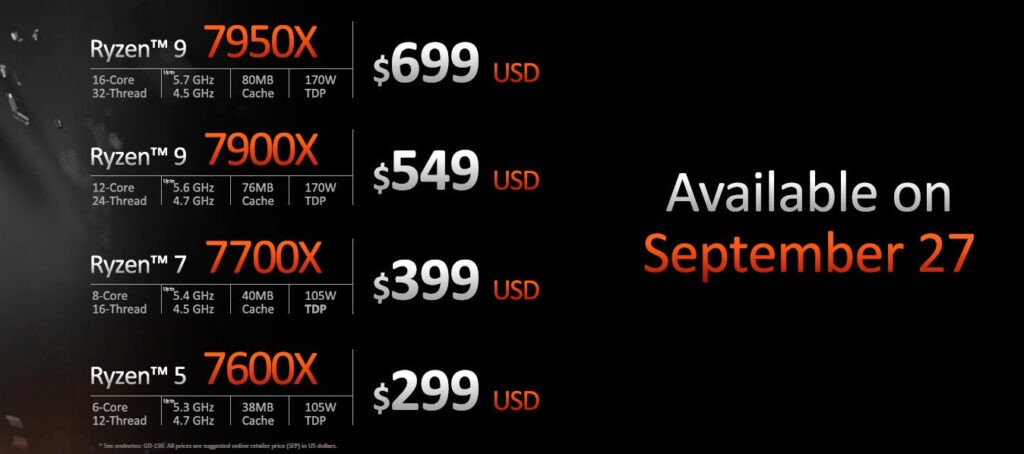
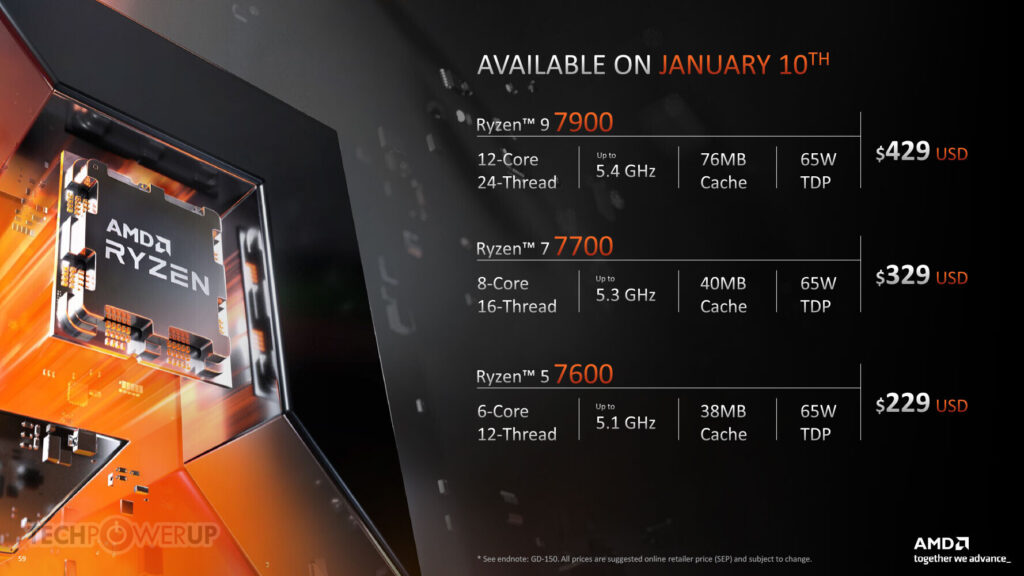
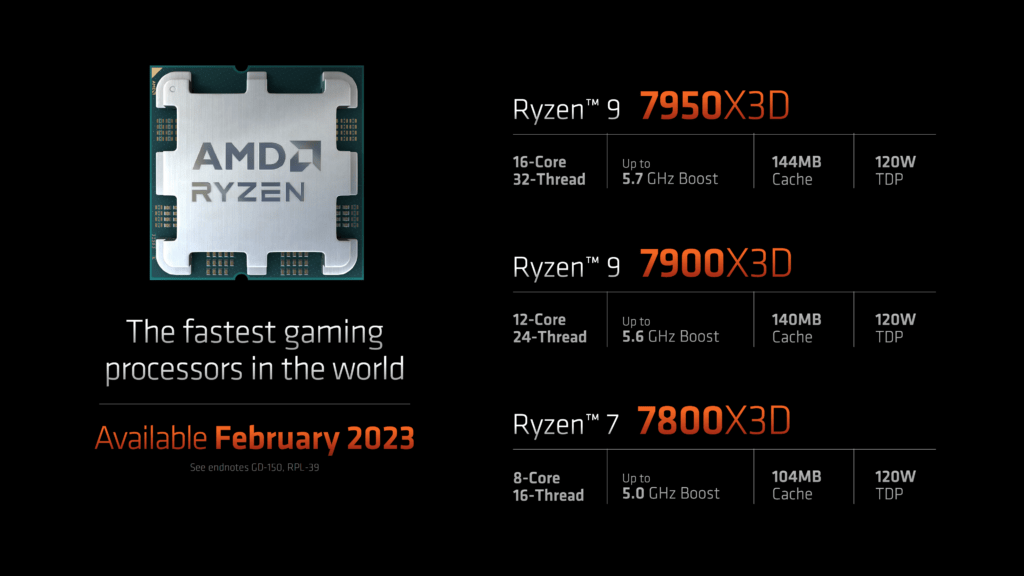
We already overclocked the Ryzen 9 7950X3D in SkatterBencher #56 and the 5800X3D in SkatterBencher #39. The Ryzen 9 7900X3D is like the 7950X3D, a dual-CCD processor with one CCD featuring 3D V-Cache technology.
I won’t say too much about the technical aspect of 3D V-Cache, as plenty of other media will cover that part of the X3D story. Long story short, AMD has a 3D-stacked additional L3 cache on top of the CCD to expand the on-die cache capacity. That, in theory, should help improve the performance in latency-sensitive workloads.
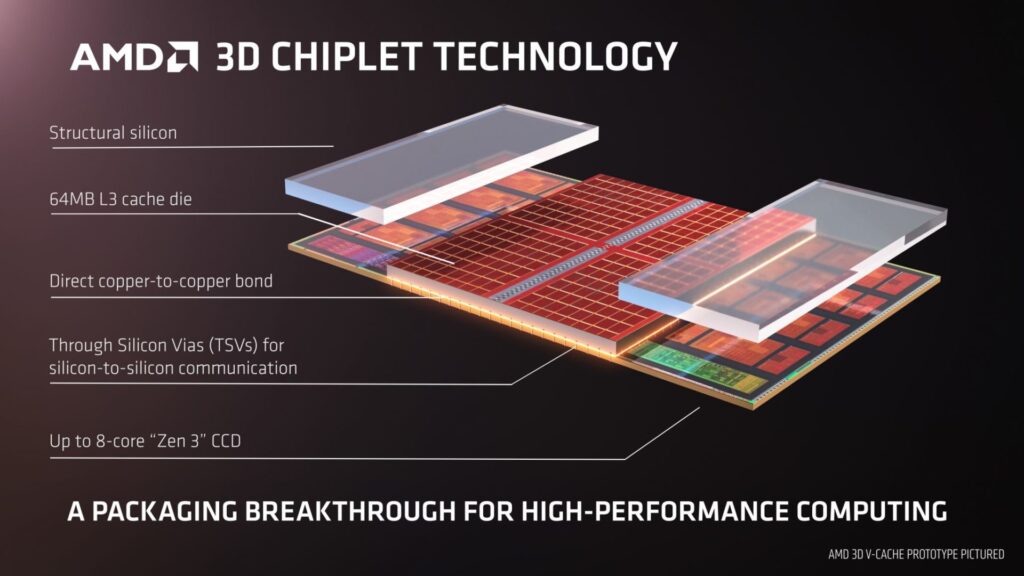
The Ryzen 9 7900X3D has two eight-core CCDs, of which two are disabled, totaling twelve cores with 24 threads. One of those CCDs has V-Cache, while the other doesn’t. The base frequency is 4.4 GHz, and the maximum listed boost frequency is 5.6 GHz. The TDP is 120W, and PPT is 162W.
In this blog post, we will cover three overclocking strategies:
- First, we rely on AMD PBO and EXPO performance boost technologies
- Second, we use the GIGABYTE PBO Enhancement feature available in the BIOS
- Third, we tune Precision Boost Overdrive with Curve Optimizer
However, before we jump into overclocking, let us quickly review the hardware and benchmarks used in this guide.
AMD Ryzen 9 7900X3D: Platform Overview
The system we’re overclocking today consists of the following hardware.
| Item | SKU | Price (USD) |
| CPU | AMD Ryzen 9 7900X3D | 599 |
| Motherboard | GIGABYTE B650I Aorus Ultra | 269 |
| CPU Cooling | EK-Quantum Velocity2 EK-Quantum Power Kit Velocity² 360 | 137 686 |
| Fan Controller | ElmorLabs EFC ElmorLabs EVC2N4 | 20 35 |
| Memory | G.SKILL Trident Z5 DDR5-6400 | 370 |
| Power Supply | Enermax MAXREVO 1500W | 370 |
| Graphics Card | ASUS ROG Strix RTX 2080 TI | 880 |
| Storage | AORUS RGB 512 GB M.2-2280 NVME | 120 |
| Chassis | XWORKS X32 | 159 |
ElmorLabs EFC & EVC2
The Elmorlabs Easy Fan Controller is the base version of the customized EFC-SB I showed on this blog.
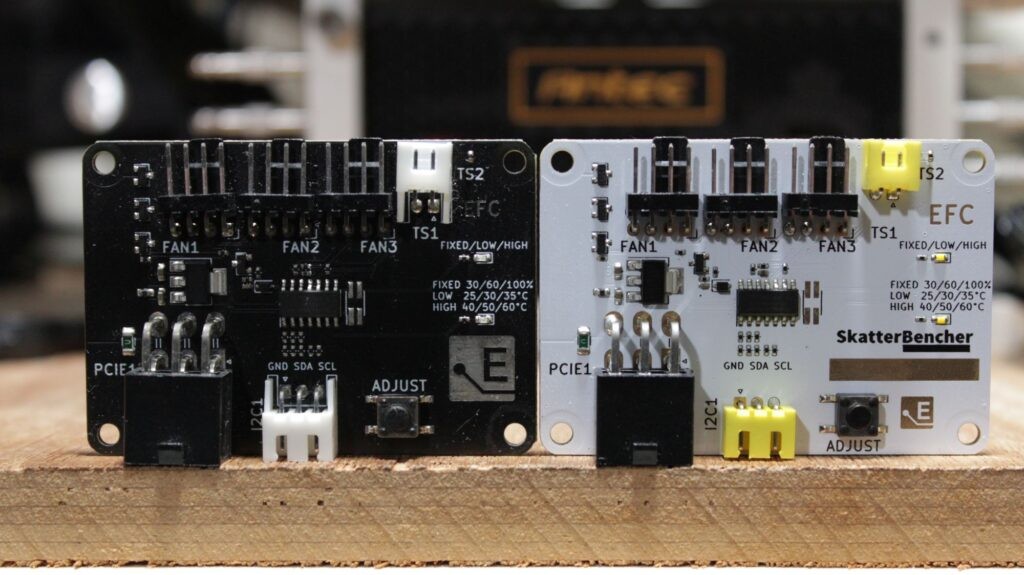
I explained how I use the EFC and EFC-SB in a separate blog post on this channel. Long story short, by connecting the EFC to the EVC2 device, I monitor the ambient temperature (EFC), water temperature (EFC), and fan duty cycle (EFC). I include the measurements in my Prime95 stability test results.
I also use the ElmorLabs EFC to map the radiator fan curve to the water temperature. Without going into too many details: I have attached an external temperature sensor from the water in the loop to the EFC. Then, I use the low/high setting to map the fan curve from 25 to 40 degrees water temperature. I use this configuration for all overclocking strategies.
The main takeaway from this configuration is that it gives us a good indicator of whether the cooling solution is saturated.

AMD Ryzen 9 7900X3D: Benchmark Software
We use Windows 11 and the following benchmark applications to measure performance and ensure system stability.
| BENCHMARK | LINK |
| SuperPI 4M | https://www.techpowerup.com/download/super-pi/ |
| Geekbench 6 | https://www.geekbench.com/ |
| Cinebench R23 | https://www.maxon.net/en/cinebench/ |
| CPU-Z | https://www.cpuid.com/softwares/cpu-z.html |
| V-Ray 5 | https://www.chaosgroup.com/vray/benchmark |
| AI-Benchmark | https://ai-benchmark.com/ |
| 3DMark CPU Profile | https://www.3dmark.com/ |
| 3DMark Night Raid | https://www.3dmark.com/ |
| CS:GO FPS Bench | https://steamcommunity.com/sharedfiles/filedetails/?id=500334237 |
| Shadow of the Tomb Raider | https://store.steampowered.com/app/750920/Shadow_of_the_Tomb_Raider_Definitive_Edition/ |
| Final Fantasy XV | http://benchmark.finalfantasyxv.com/na/ |
| Prime 95 | https://www.mersenne.org/download/ |
AMD Ryzen 9 7900X3D: Stock Performance
Before starting overclocking, we must check the system performance at default settings. Note that the Precision Boost 2 boosting algorithm governs the performance over base specification. The standard parameters of the Precision Boost algorithm for the Ryzen 9 7900X3D are as follows:
- PPT: 162W
- TDC: 120A
- EDC: 180A
- THM: 89C
- VID: 1.200V (CCD0), 1.400V (CCD1)
- FMAX: 5150 (CCD0), 5650 (CCD1)

These values don’t tell the whole picture of how Precision Boost works on the 7000X3D processors. I’ll get back to that later in the article.
Here is the benchmark performance at stock:
- SuperPI 4M: 29.855 seconds
- Geekbench 6 (single): 2,871 points
- Geekbench 6 (multi): 16,390 points
- Cinebench R23 Single: 2,013 points
- Cinebench R23 Multi: 27,302 points
- CPU-Z V17.01.64 Single: 720.1 points
- CPU-Z V17.01.64 Multi: 11,261.5 points
- V-Ray 5: 20,764 vsamples
- AI Benchmark: 5,710 points
- 3DMark Night Raid: 76,760 points
- CS:GO FPS Bench: 635.49 fps
- Tom Raider: 205 fps
- Final Fantasy XV: 204.02 fps
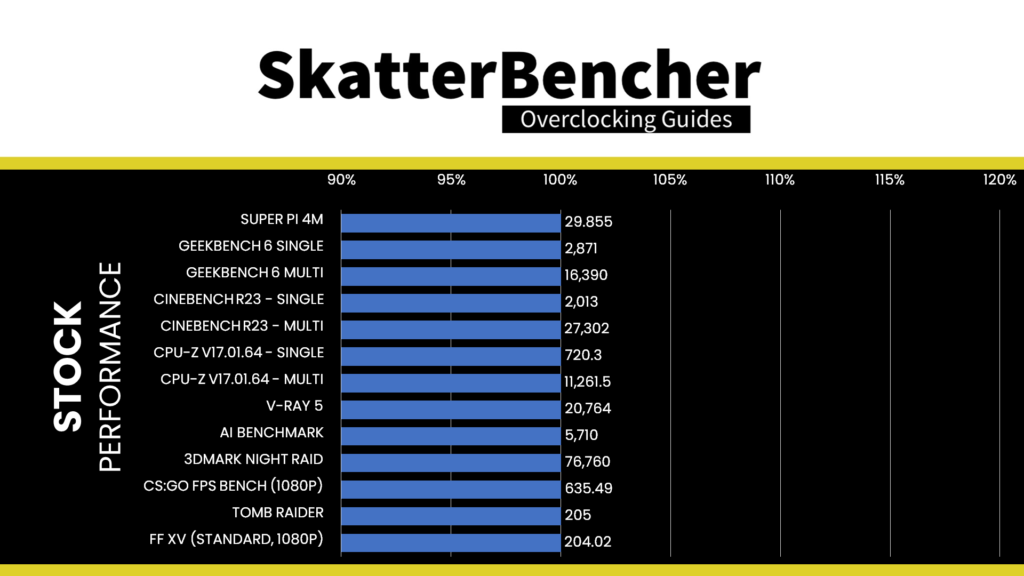
Here are the 3DMark CPU Profile scores at stock
- CPU Profile 1 Thread: 1,116
- CPU Profile 2 Threads: 2,160
- CPU Profile 4 Threads: 4,248
- CPU Profile 8 Threads: 7,526
- CPU Profile 16 Threads: 10,722
- CPU Profile Max Threads: 11,682
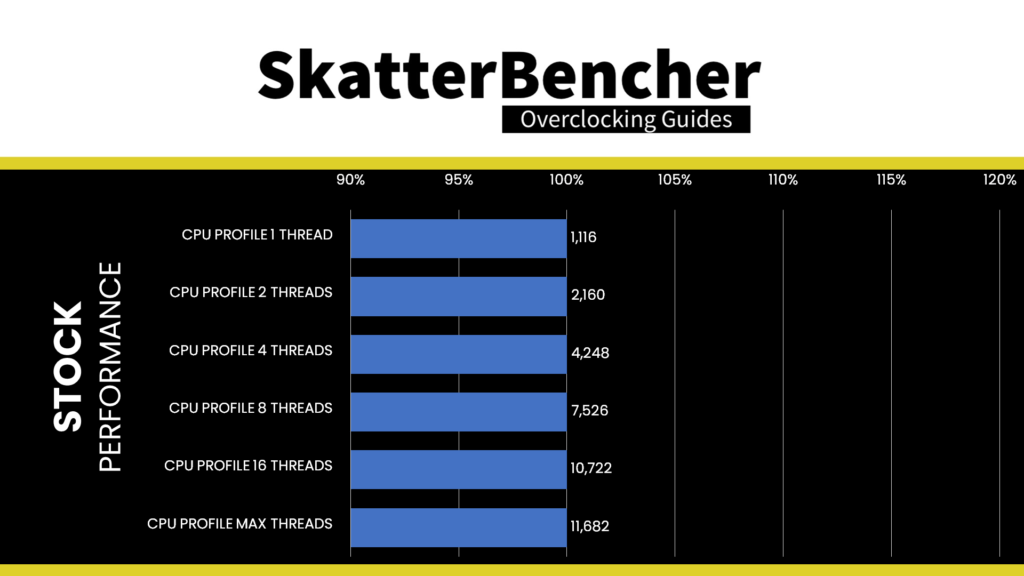
When running Prime 95 Small FFTs with AVX-512 enabled, the average CPU effective clock is 4275 MHz with 0.933 volts. The average CPU temperature is 61.2 degrees Celsius. The ambient and water temperature is 24.0 and 38.7 degrees Celsius. The average CPU package power is 105.8 watts.

When running Prime 95 Small FFTs with AVX disabled, the average CPU effective clock is 4578 MHz with 0.997 volts. The average CPU temperature is 74.5 degrees Celsius. The ambient and water temperature is 23.5 and 28.5 degrees Celsius. The average CPU package power is 115.1 watts.
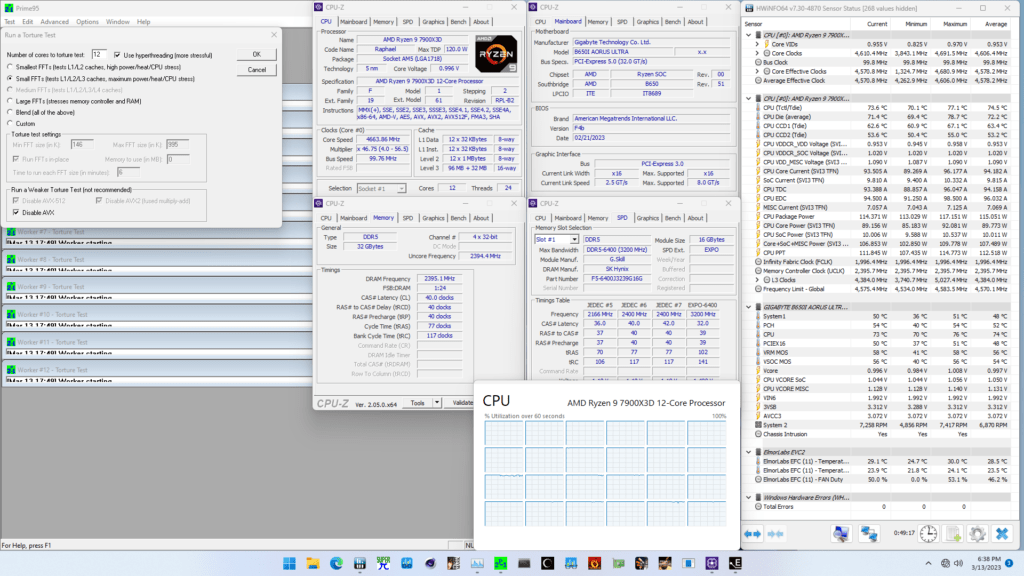
Now, let us try our first overclocking strategy.
However, before we get going, make sure to locate the CMOS Clear Jumper
Shorting the Clear CMOS jumper will reset all your BIOS settings to default which is helpful if you want to start your BIOS configuration from scratch. However, it does not delete any of the BIOS profiles previously saved. The Clear CMOS jumper is at the motherboard’s bottom, right above the PCIe slot.
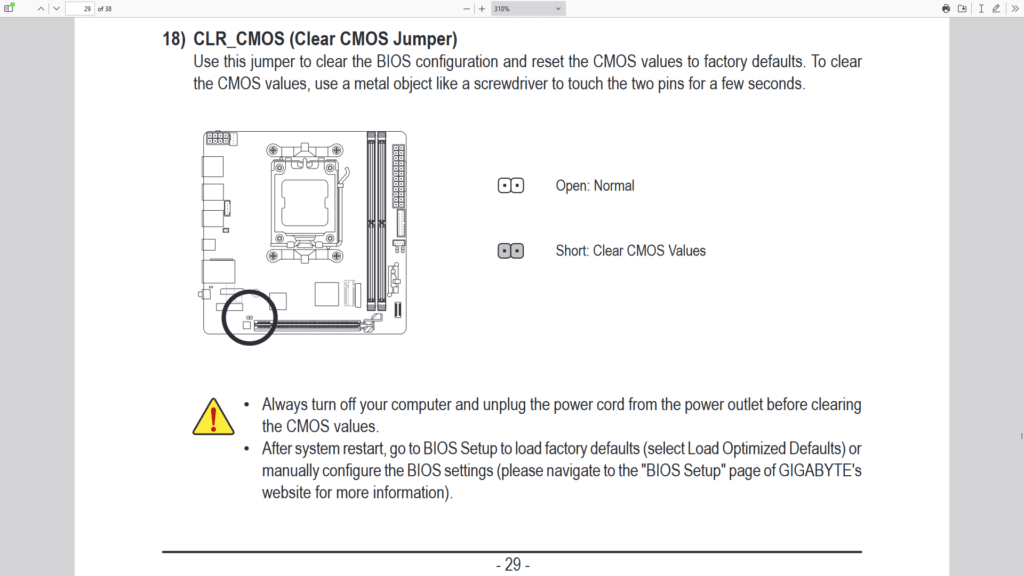
OC Strategy #1: PBO 2 + EXPO
In our first overclocking strategy, we take advantage of AMD-exclusive features Precision Boost Overdrive 2 and Extended Profiles for Overclocking. However, before discussing Precision Boost Overdrive, let’s return to Precision Boost.
I spoke at length about the Precision Boost 2 technology in my “Raphael Overclocking: What’s New” launch article. To better understand what I’m going to explain about Ryzen 9 7900X3D overclocking, it’s vital to understand the basics of Precision Boost technology.
PB 2 – Precision Boost 2
Precision Boost 2 is an automatic performance-maximizing technology available in all AMD Ryzen processors since the 2018 Ryzen 2000 series. This technology improves system performance by dynamically increasing your processor clock speeds beyond stock depending on many factors, including temperature, power consumption, current draw, and the number of active cores.
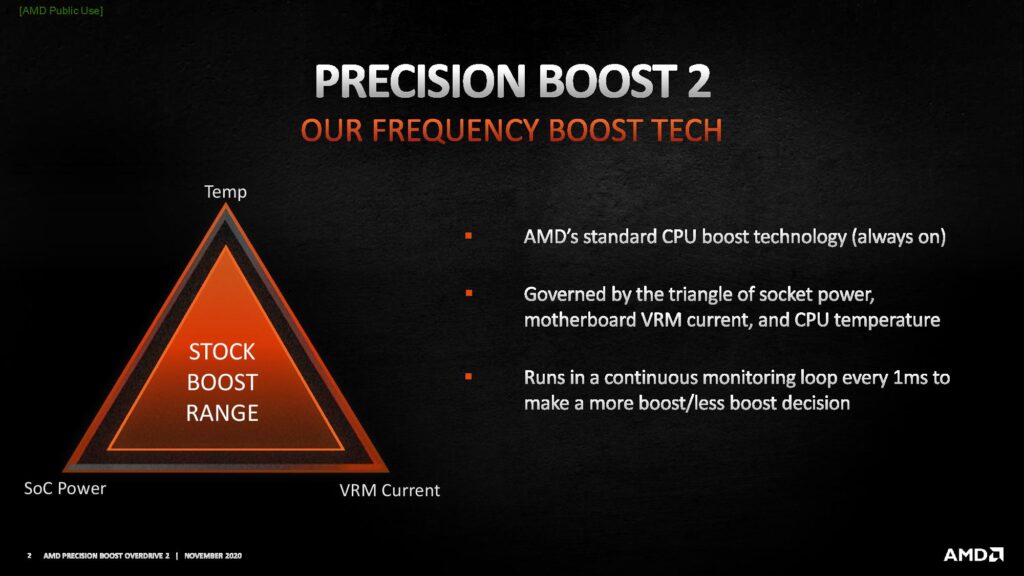
SMU – System Management Unit
The fundamental building block of the Precision Boost 2 algorithm is the SMU or System Management Unit.
Each chip on your Raphael CPU has an SMU, meaning there are 3 SMUs on a Ryzen 9 7900X3D CPU. One of those SMUs functions as Master SMU, while the others work as Slave SMUs. Typically, the SMU in the IO die would be the Master SMU. All SMUs are connected using a low-bandwidth control bus called SCF or Scalable Control Fabric.
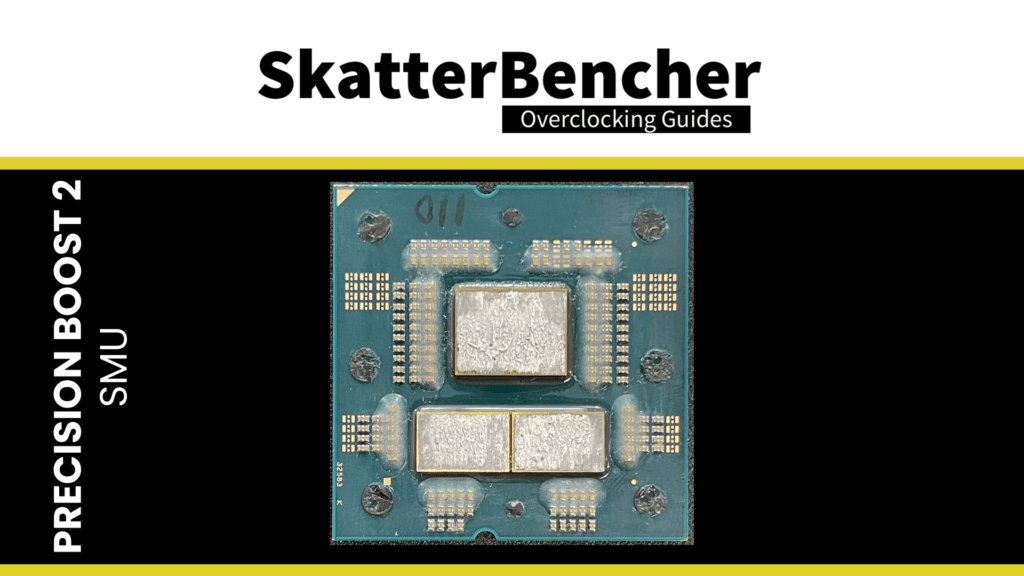
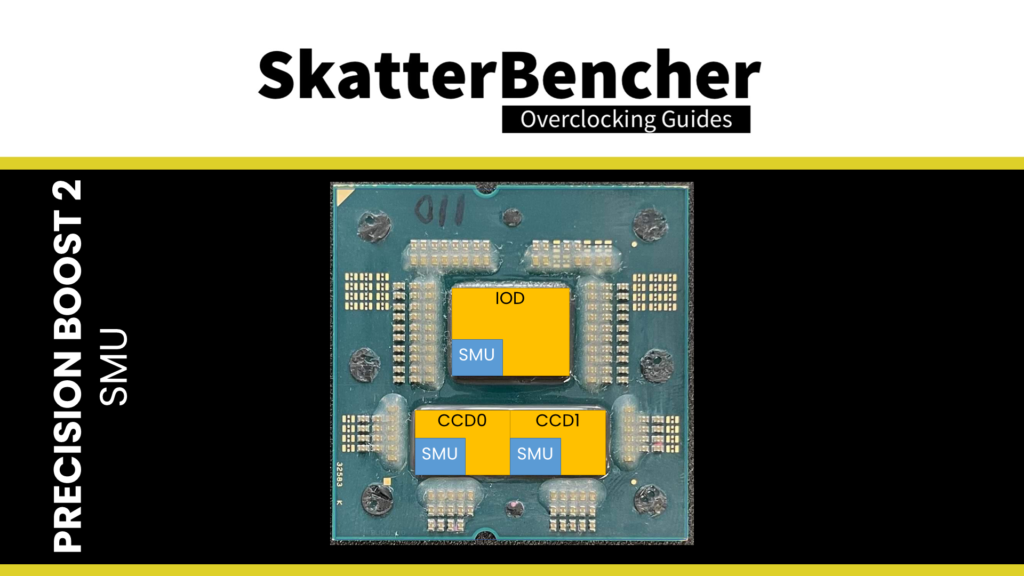
The SMU has a range of capabilities, including, most importantly, the ability to manage the CPU performance within the infrastructure constraints. The infrastructure restricts the maximum operating limits on various metrics, including power draw, temperature, and voltage.
The primary function of the slave SMUs is to capture the measurement data related to the infrastructure limits, then prepare that data to be sent to the master SMU. The master SMU’s primary function is to analyze the package-wide measurement data and determine the actions needed for performance management.
Each infrastructure limit has its algorithm and is managed independently by the master SMU to determine the infrastructure-limited frequency. The firmware then selects the most constraining limit as the global frequency limit.

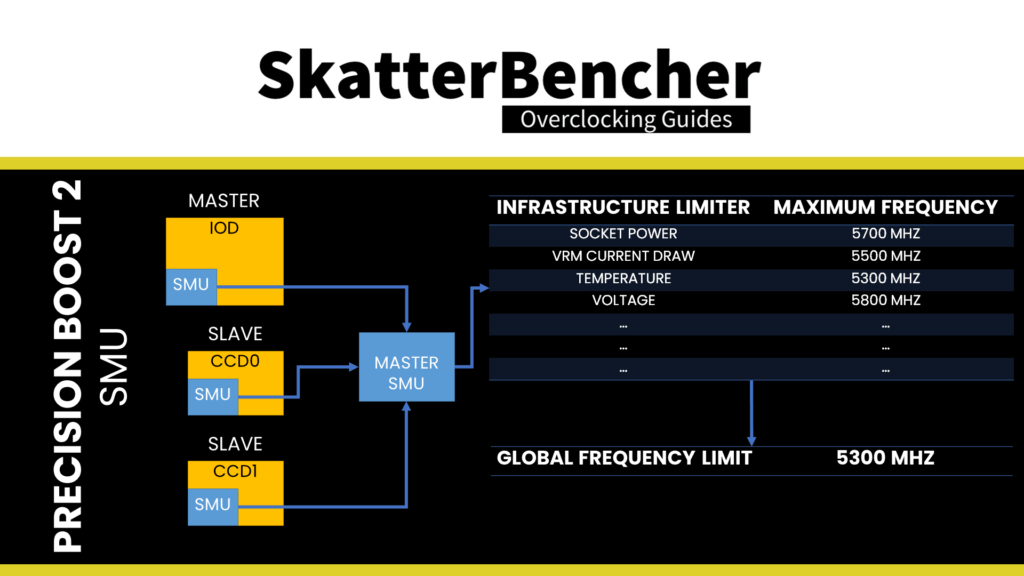
Then, either of two things can happen: the current frequency exceeds the limit, or it doesn’t. If it does, the frequency is reduced. If it doesn’t, there’s frequency headroom, and the frequency will increase. Either way, the master SMU passes the frequency change request to the slave, and each slave applies the frequency changes to the CPU cores of the local die. The frequency changes are coordinated with the global voltage plane by the master SMU.

Now comes the part that’s important for Ryzen 7000X3D!
Every slave SMU can make independent decisions based on local conditions. So, it can apply lower frequencies than the frequency requested by the master SMU if the on-die conditions require so. For example, one CCX may run at a lower frequency in all-core workloads. Additionally, when dLDO is enabled, each SMU can independently adjust the voltage for each core within the CCX.
Precision Boost Infrastructure Limiters
The Precision Boost algorithm has many infrastructure limiters, some of which are also exposed to the end user. While all these limiters are on a Ryzen 7000 CPU, it doesn’t mean they’re all active or configured. Furthermore, the infrastructure limiters are not the same for both CCDs as CCD0, with V-Cache, is severely more constrained than CCD1 without V-Cache!
Here’s a list of the Precision Boost limiters we’re aware of. I discussed these in my “Raphael Overclocking: What’s New” launch article, so I’ll discuss only the relevant ones for the Ryzen 9 7900X3D.

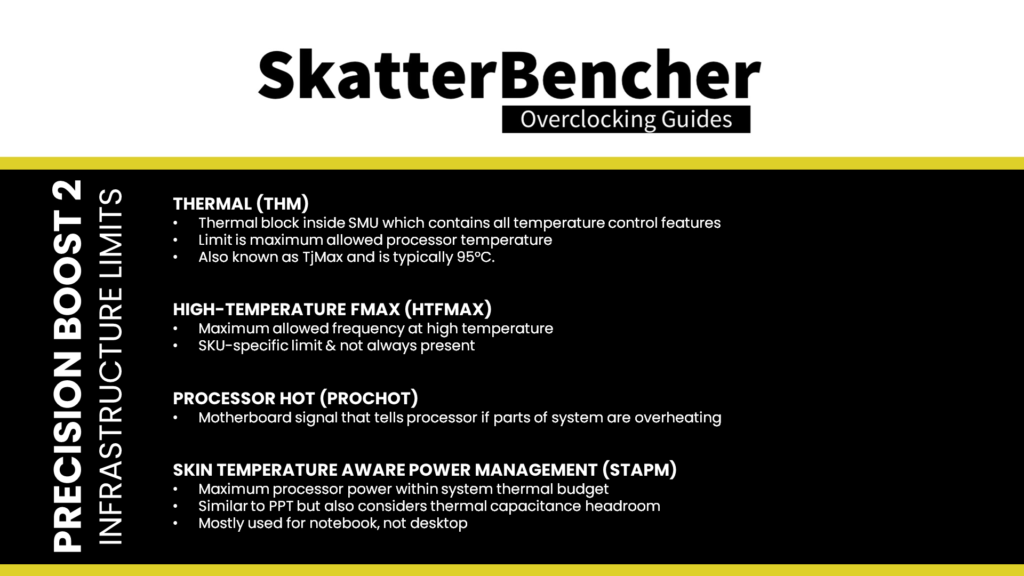
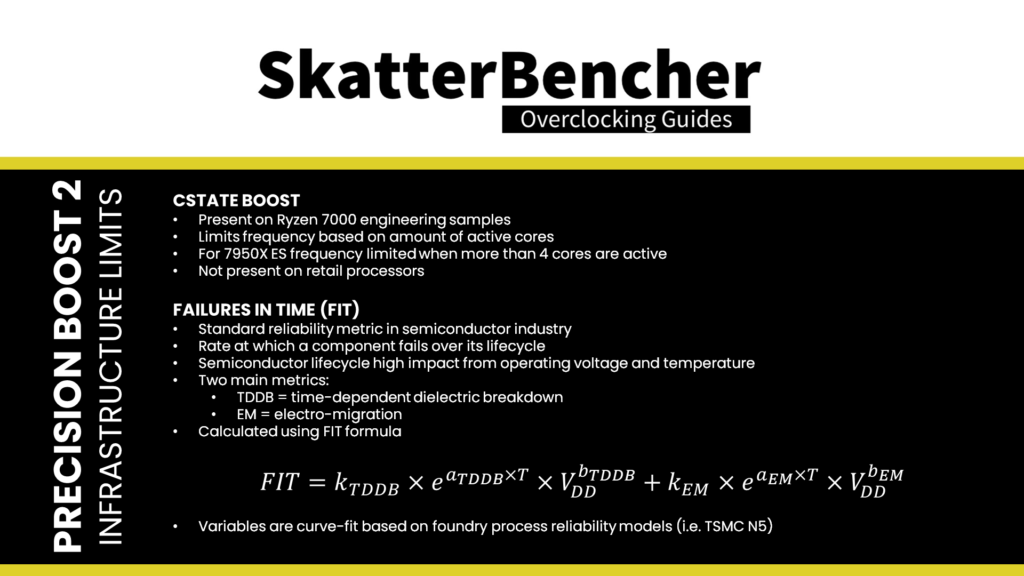
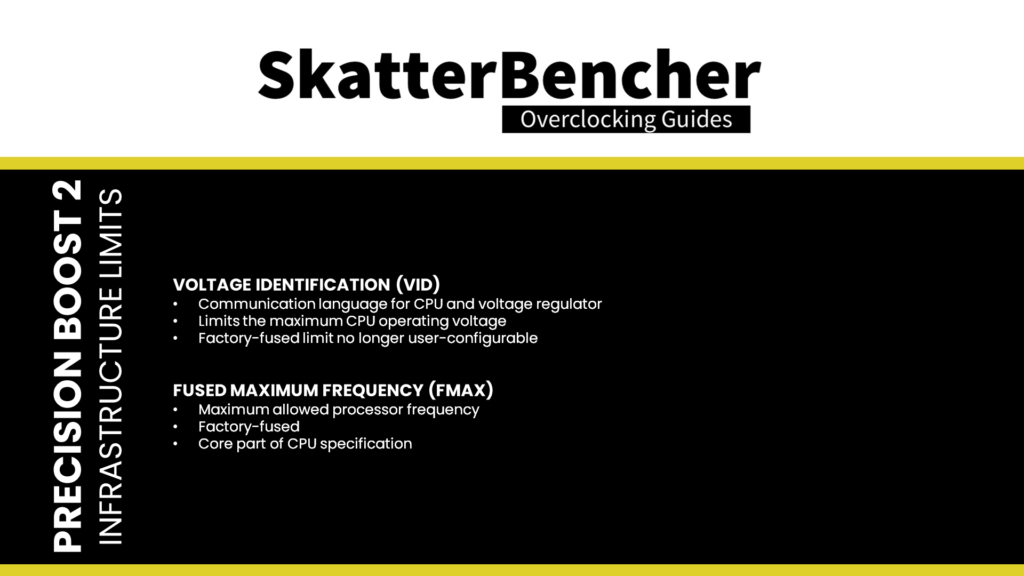
The main limiter constraining the Ryzen 9 7900X3D is the voltage limit.
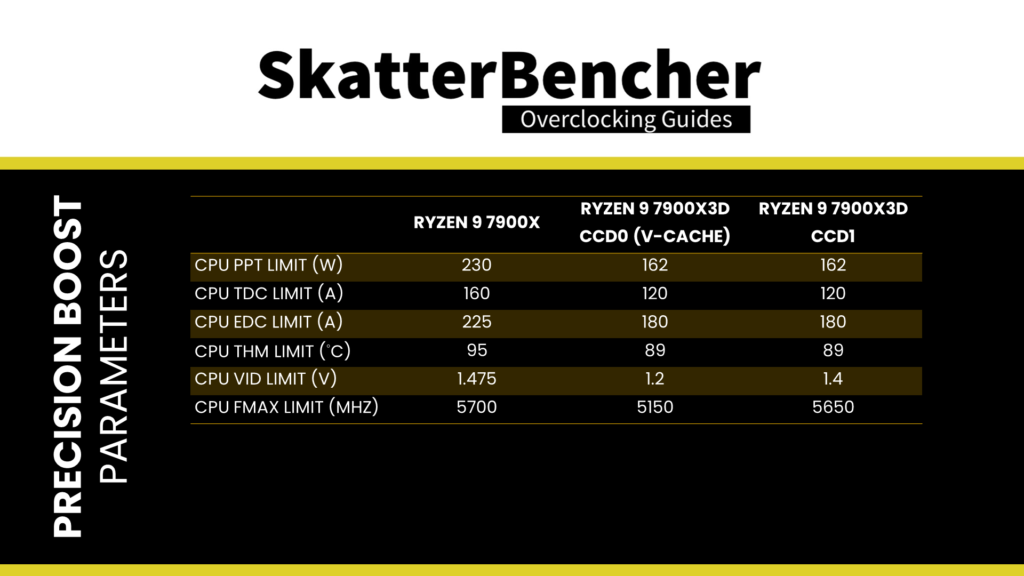
I will refer to the V-Cache CCD as CCD0 and the non-V-Cache CCD as CCD1.
As you can see from the table, the VID limit for both Ryzen 7000X3D CCDs is lower than that of a regular 7900X processor. Furthermore, at 1.2V, the voltage limit for CCD0 is significantly lower than for CCD1.
Raphael only has one VDDCR voltage rail powering the CPU cores in the CCDs via the VDDCR_CPU rail and the cache via the VDDCR_VDDM rail. As I discussed in my Raphael launch article, it means that when any core in CCD0 is active, it will also restrict the maximum voltage for the cores in CCD1. That will also constrain its operating frequency.
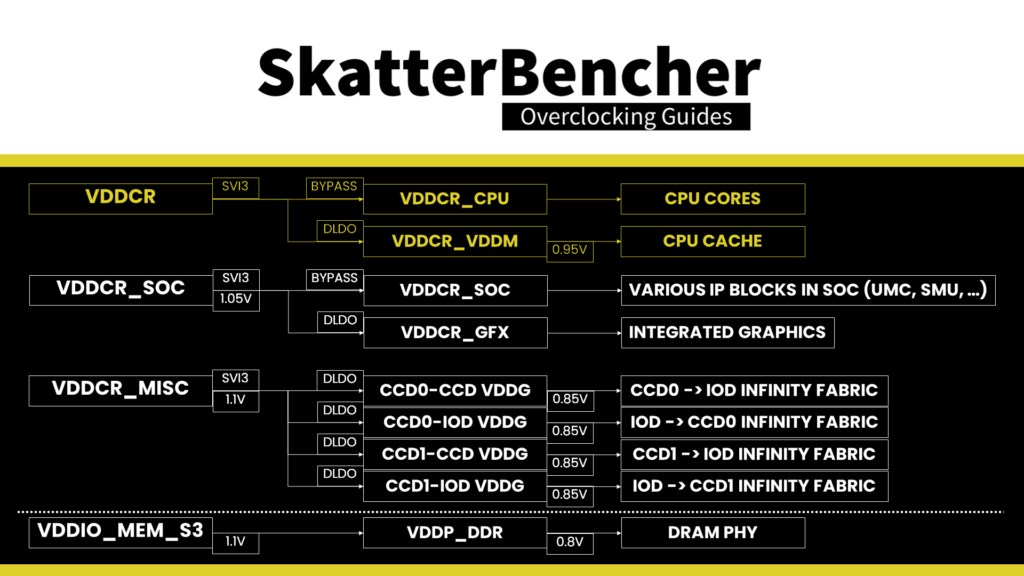
Note that the voltage limits are the absolute limits at zero load. When the CPU is under a substantial load, the Precision Boost algorithm will further restrict the allowed voltage. The maximum voltage in an all-core workload with active cores in CCD0 is a mere 1.0V. That’s similar to the maximum voltage for a stock non-X Ryzen 7000 processor. The maximum voltage in an all-core workload for CCD1 is 1.2V
Another limit constraining the Ryzen 9 7900X3D is the Fmax limit. Unsurprisingly, the CCD with V-Cache cannot run at equivalent speeds to the non-V-Cache CCD since the L3 Cache operates at the same frequency. We also saw this with the Ryzen 7 5800X3D, which had a 200 MHz lower maximum boost clock than the Ryzen 7 5800X. On the Ryzen 9 7950X3D, CCD0 has a Fmax of 5150 MHz, and CCD1 has a Fmax of 5650 MHz.
That concludes our shallow dive into the Precision Boost 2 technology. There’s much more to tell about Ryzen 7000 frequency and voltage configuration, but I’ll refer you to my Raphael launch content.
It’s time to move on to the Ryzen 7000X3D overclocking and Precision Boost Overdrive 2.
PBO 2 – Precision Boost Overdrive 2
With the launch of Zen 3, AMD introduced an improved version of the Precision Boost Overdrive toolkit, allowing for manual tuning of the parameters affecting the Precision Boost frequency boost algorithm.
Precision Boost Overdrive 2 builds on the PBO implementation of Zen 2. In addition to the platform overclocking knobs from Zen+ (PPT, TDC, EDC) and processor overclocking knobs from Zen 2 (Boost Override and Scalar), Precision Boost Overdrive 2 introduces Curve Optimizer.
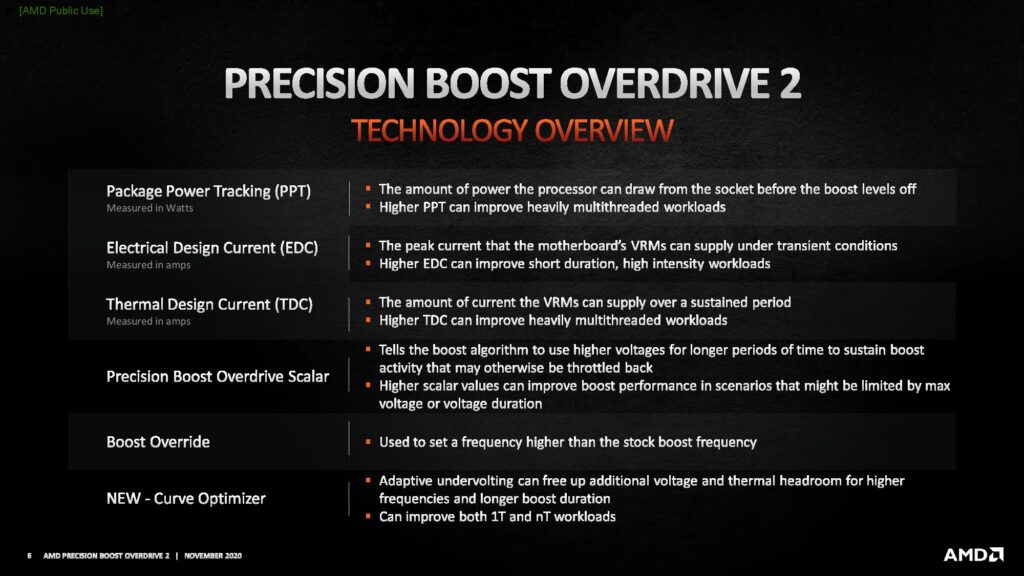
There are essentially 3 levels of Precision Boost Overdrive
- AMD’s stock values, which can be set by disabling PBO
- The motherboard vendor values, which are programmed into the BIOS to match the motherboard VRM specification and can be set by enabling PBO
- Custom values, which the end-user can program
In this overclocking strategy, we’re just enabling Precision Boost Overdrive, whereas, in the following strategies, we’ll explore tuning the parameters.

We rely on the motherboard’s pre-programmed PBO parameters by enabling Precision Boost Overdrive. We find that the following values have changed:
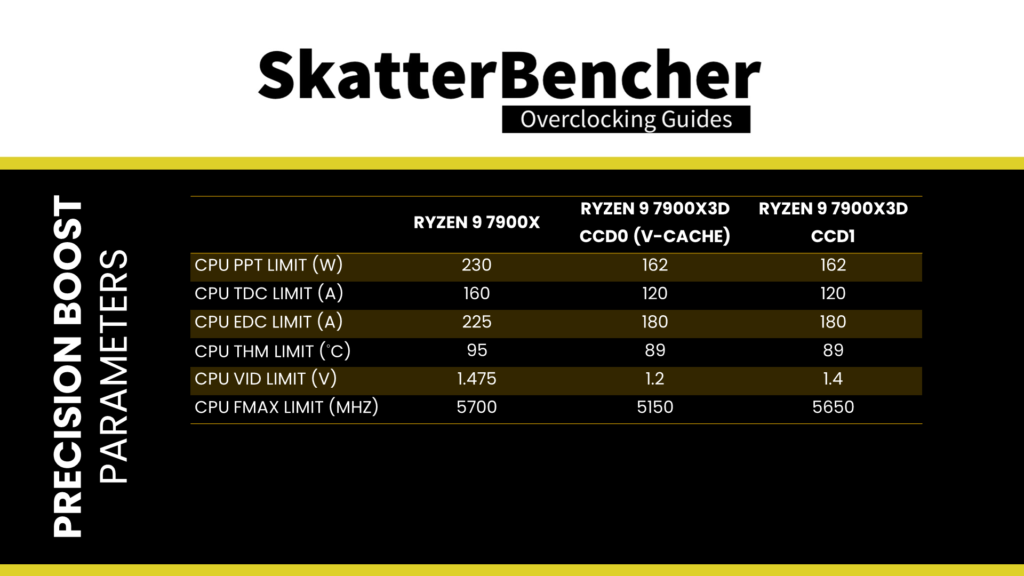
For previous Ryzen CPUs, increasing the platform boost parameters substantially impacted performance, especially for the higher core-count CPUs. For Ryzen 7000 X-series CPUs, however, AMD’s default platform parameters were relatively unconstraining.
For the 7900X3D, it’s clear that the platform boost limiters are not the constraining factor. During a Prime95 non-AVX workload, we see that maximum values for PPT, TDC, and EDC are 115W, 96A, and 98A, respectively. The main limiting factor for the 7900X3D is the maximum allowed voltage for the V-Cache CCD, which is around 1V under a high load.
EXPO – Extended Profiles for Overclocking
EXPO stands for AMD Extended Profiles for Overclocking. It is an AMD technology that enables ubiquitous memory overclocking profiles for AMD platforms supporting DDR5 memory. EXPO allows memory vendors such as G.SKILL to program higher performance settings onto the memory sticks. If the motherboard supports EXPO, you can enable higher performance with a single BIOS setting. So, it saves you lots of manual configuration.

While our memory kit is rated at DDR5-6400, I had to run it at DDR5-6000 for stability reasons, as my CPU wasn’t stable at higher frequencies.
BIOS Settings & Benchmark Results
Upon entering the BIOS
- Switch to Advanced Mode
- Enter the Advanced CPU Settings sub-menu
- Enter the Precision Boost Overdrive sub-menu
- Set Precision Boost Overdrive to Enabled
- Leave the Precision Boost Overdrive sub-menu
- Enter the Precision Boost Overdrive sub-menu
- Leave the Advanced CPU Settings sub-menu
- Set Extreme Memory Profile(XMP/EXPO) to EXPO 1
- Set System Memory Multiplier to 60.00
Then save and exit the BIOS.
We re-ran the benchmarks and checked the performance increase compared to the default operation.
- SuperPI 4M: +1.71%
- Geekbench 6 (single): +0.56%
- Geekbench 6 (multi): +7.10%
- Cinebench R23 Single: +0.15%
- Cinebench R23 Multi: +0.27%
- CPU-Z V17.01.64 Single: +0.04%
- CPU-Z V17.01.64 Multi: +1.08%
- V-Ray 5: +3.15%
- AI Benchmark: +6.80%
- 3DMark Night Raid: +0.87%
- CS:GO FPS Bench: +0.22%
- Tomb Raider: +0.00%
- Final Fantasy XV: +0.36%
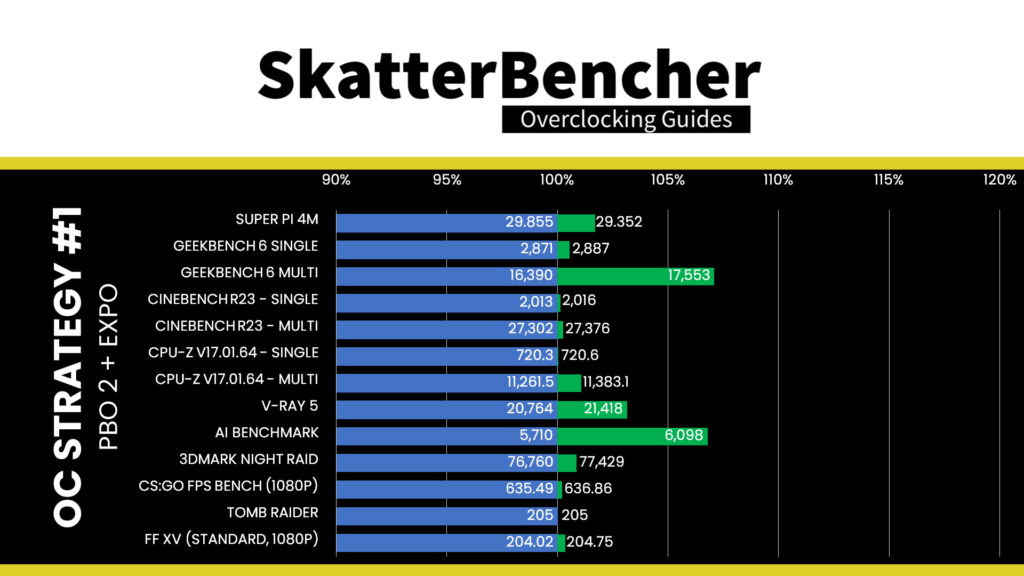
Here are the 3DMark CPU Profile scores:
- CPU Profile 1 Thread: +0.00%
- CPU Profile 2 Threads: +1.53%
- CPU Profile 4 Threads: +0.45%
- CPU Profile 8 Threads: +0.45%
- CPU Profile 16 Threads: +0.12%
- CPU Profile Max Threads: +0.72%

As expected, enabling Precision Boost Overdrive does little to improve the system’s performance. After all, the CPU is primarily limited by operating voltage, not by any platform power parameters. Thanks to enabling EXPO, we get a performance improvement of +7.10% in Geekbench 6 Multi.
When running Prime 95 Small FFTs with AVX-512 enabled, the average CPU effective clock is 4258 MHz with 0.934 volts. The average CPU temperature is 63.1 degrees Celsius. The ambient and water temperature is 26.1 and 31.0 degrees Celsius. The average CPU package power is 119.5 watts.
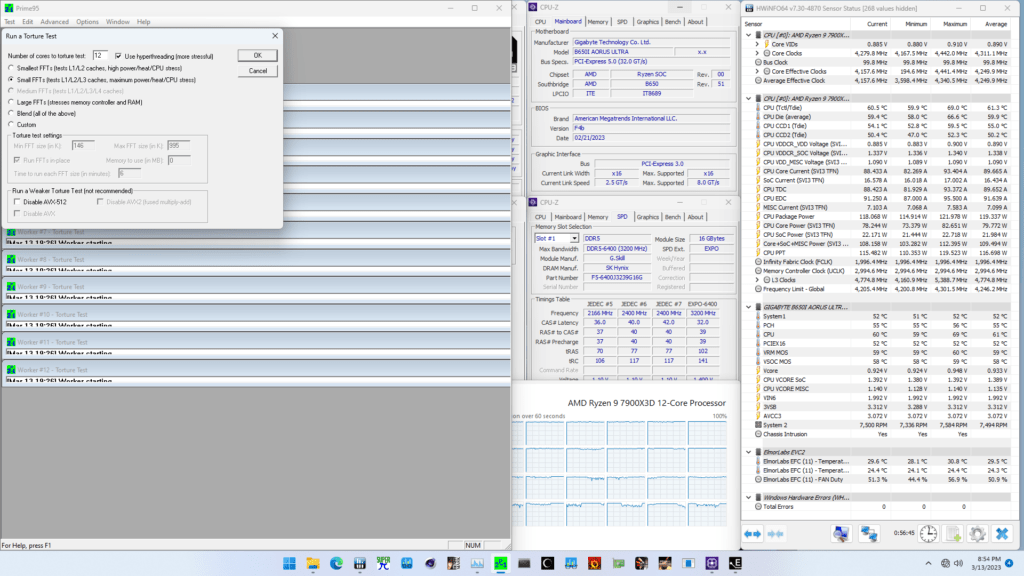
When running Prime 95 Small FFTs with AVX disabled, the average CPU effective clock is 4568 MHz with 0.996 volts. The average CPU temperature is 75.6 degrees Celsius. The ambient and water temperature is 24.0 and 29.5 degrees Celsius. The average CPU package power is 129.4 watts.
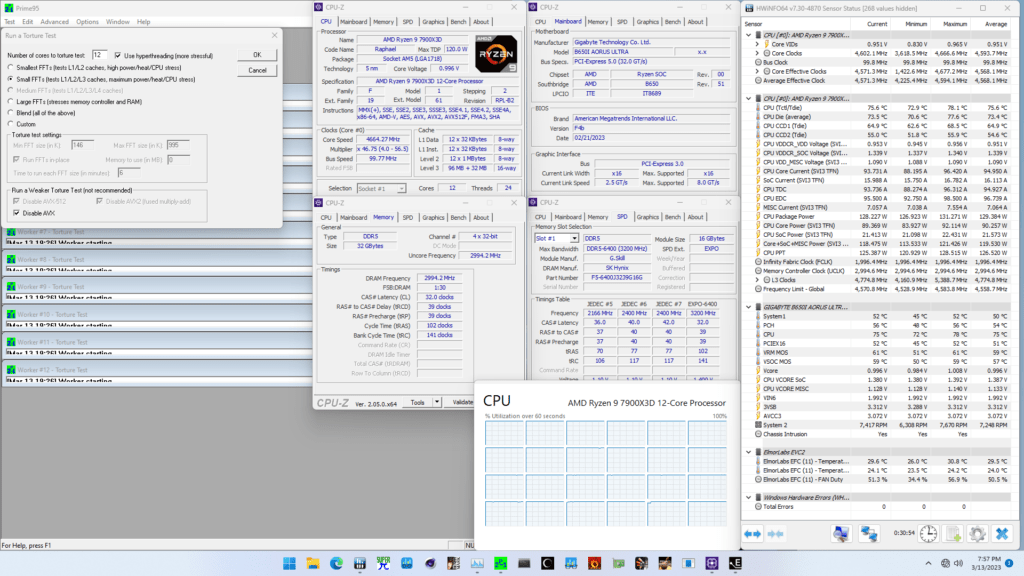
OC Strategy #2: GIGABYTE PBO Enhancement
In our second overclocking strategy, we use the GIGABYTE PBO Enhancement feature integrated into the GIGABYTE BIOS.
GIGABYTE PBO Enhancement
GIGABYTE PBO Enhancement, formerly Performance Bung, is a new performance-oriented technology in the GIGABYTE AM5 motherboard BIOSes. Essentially it’s a list of preset profiles to configure Precision Boost Overdrive. The profiles configure two things specifically:
- The maximum allowed temperature
- An all-core Curve Optimizer setting
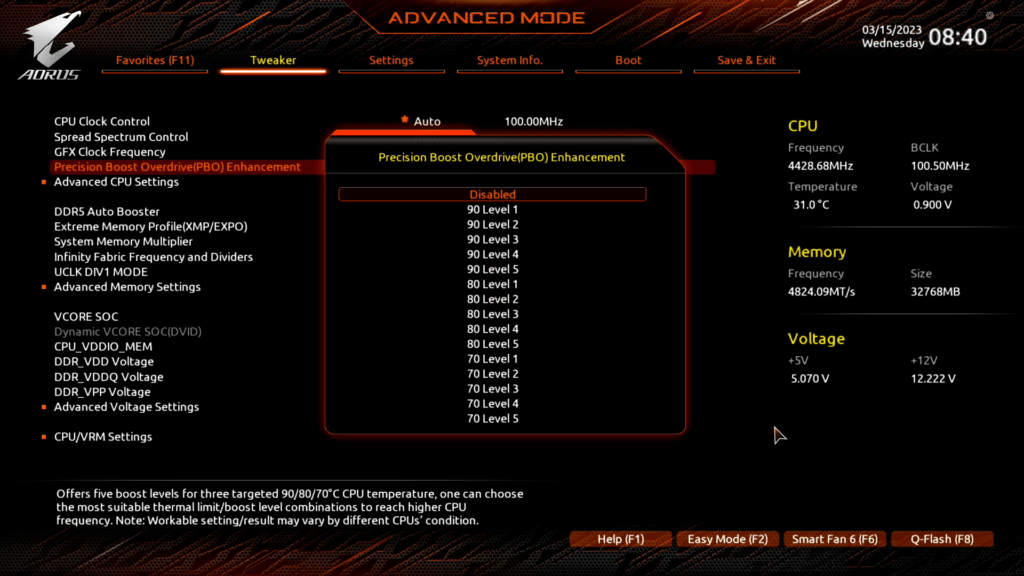
For example, this strategy’s “90 Level 1” profile will set the maximum temperature to 90 degrees Celsius and an all-core Curve Optimizer of -10. However, since the maximum temperature of the X3D CPUs is only 89 degrees Celsius, it won’t override that.
You can select your preferred profile based on the maximum temperature you’re comfortable with and how well your CPU can undervolt. A lower maximum temperature will yield lower CPU frequency in all-core workloads. A higher negative Curve Optimizer will push the CPU frequency higher at a similar voltage.
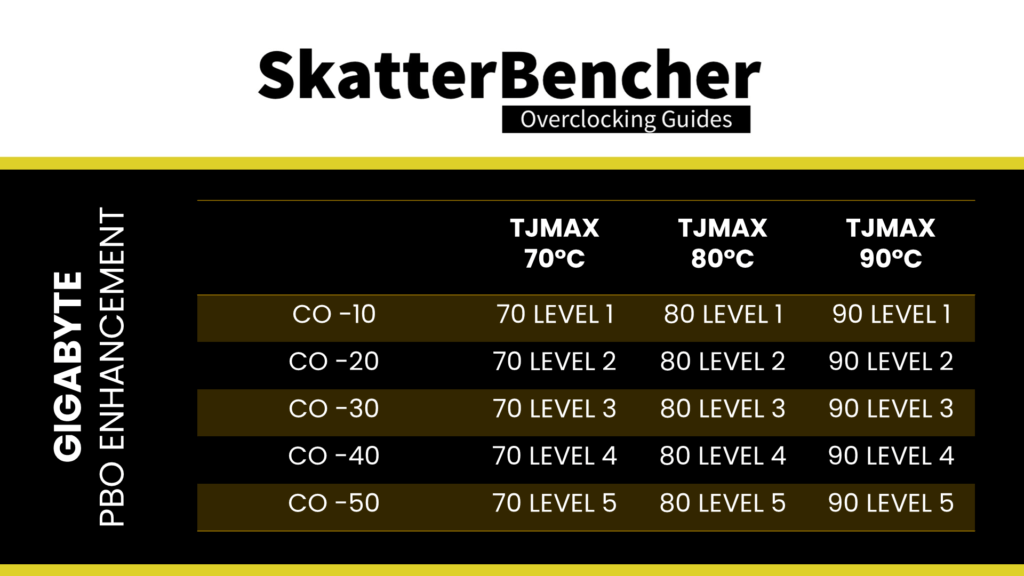
Note that PBO Enhancement does not adjust the Precision Boost power limits. So you want to ensure the PPT, TDC, and EDC are also set correctly to maximize the performance.
BIOS Settings & Benchmark Results
Upon entering the BIOS
- Switch to Advanced Mode
- Set Precision Boost Overdrive(PBO) Enhancement to 90 Level 1
- Enter the Advanced CPU Settings sub-menu
- Enter the Precision Boost Overdrive sub-menu
- Set Precision Boost Overdrive to Advanced
- Set PBO Limits to Motherboard
- Leave the Precision Boost Overdrive sub-menu
- Leave the Advanced CPU Settings sub-menu
- Set Extreme Memory Profile(XMP/EXPO) to EXPO 1
- Set System Memory Multiplier to 60.00
Then save and exit the BIOS.
We re-ran the benchmarks and checked the performance increase compared to the default operation.
- SuperPI 4M: +2.22%
- Geekbench 6 (single): +1.78%
- Geekbench 6 (multi): +7.88%
- Cinebench R23 Single: +0.75%
- Cinebench R23 Multi: +1.68%
- CPU-Z V17.01.64 Single: +0.19%
- CPU-Z V17.01.64 Multi: +3.26%
- V-Ray 5: +3.87%
- AI Benchmark: +7.27%
- 3DMark Night Raid: +2.14%
- CS:GO FPS Bench: +0.61%
- Tomb Raider: +0.00%
- Final Fantasy XV: +1.07%
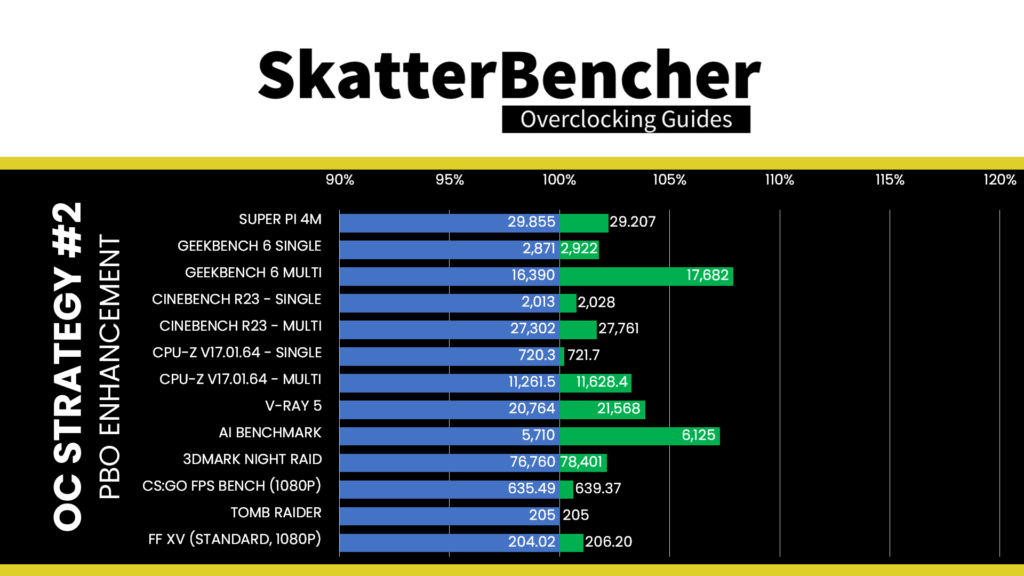
Here are the 3DMark CPU Profile scores
- CPU Profile 1 Thread: +0.72%
- CPU Profile 2 Threads: +2.41%
- CPU Profile 4 Threads: +0.97%
- CPU Profile 8 Threads: +1.67%
- CPU Profile 16 Threads: +3.44%
- CPU Profile Max Threads: +2.17%

While the performance uplift after Curve Optimizing is not earth-shattering, it’s nice to see we achieve slightly better performance across the board. We see the highest performance improvement of +7.88% in Geekbench 6 Multi.
When running Prime 95 Small FFTs with AVX-512 enabled, the average CPU effective clock is 4343 MHz with 0.927 volts. The average CPU temperature is 61.7 degrees Celsius. The ambient and water temperature is 24.3 and 29.7 degrees Celsius. The average CPU package power is 119.9 watts.
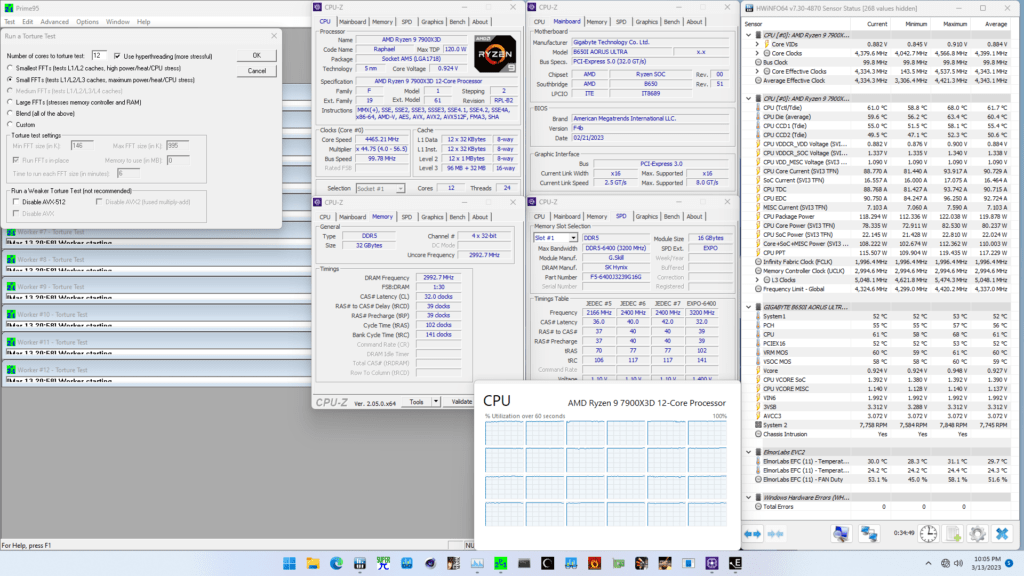
When running Prime 95 Small FFTs with AVX disabled, the average CPU effective clock is 4653 MHz with 0.992 volts. The average CPU temperature is 75.8 degrees Celsius. The ambient and water temperature is 24.3 and 29.8 degrees Celsius. The average CPU package power is 129.6 watts.

OC Strategy #3: PBO Tuned with Curve Optimizer
In our third overclocking strategy, we will use Fmax Boost Override and the Curve Optimizer tool included in the Precision Boost Overdrive 2 overclocker’s toolkit.
PBO 2: Fmax Boost Override
Fused maximum frequency, or Fmax, is one of the Precision Boost infrastructure limiters constraining the CPU performance. The limiter determines the maximum allowed processor frequency across all CPU cores inside your CPU.
Boost Clock Override, or Fmax Override, is one of the overclocker tools available in the PBO 2 toolkit. It allows the user to override the arbitrary clock frequency limit between -1000 MHz and +200 MHz in steps of 25 MHz. It is available for both the CPU core clock and, if present, the Graphics core clock.
We need to make two important notes about Boost Clock Override:
- The override only adjusts the upper ceiling of the frequency and doesn’t act as a frequency offset. Ultimately, the Precision Boost 2 algorithm still determines the actual operating frequency.
- CCD0 – the one with V-Cache – appears locked from increasing the Fmax. So, while setting a negative boost override to lower the Fmax works, setting a positive boost override to increase the Fmax doesn’t work. The Fmax remains at 5150 MHz.
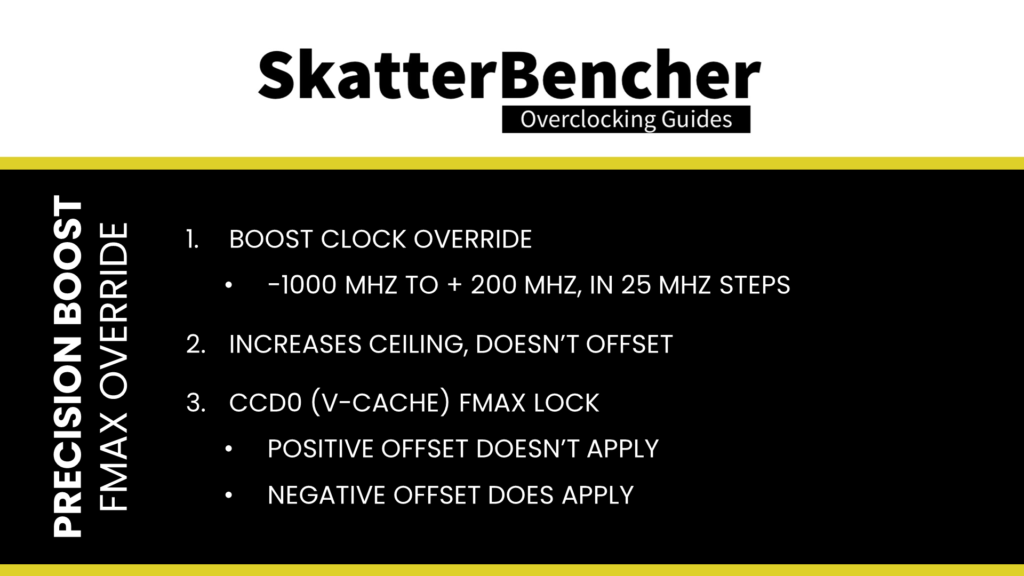
PBO 2: Curve Optimizer
As mentioned in this guide, Curve Optimizer is an important new feature of Precision Boost Overdrive 2.
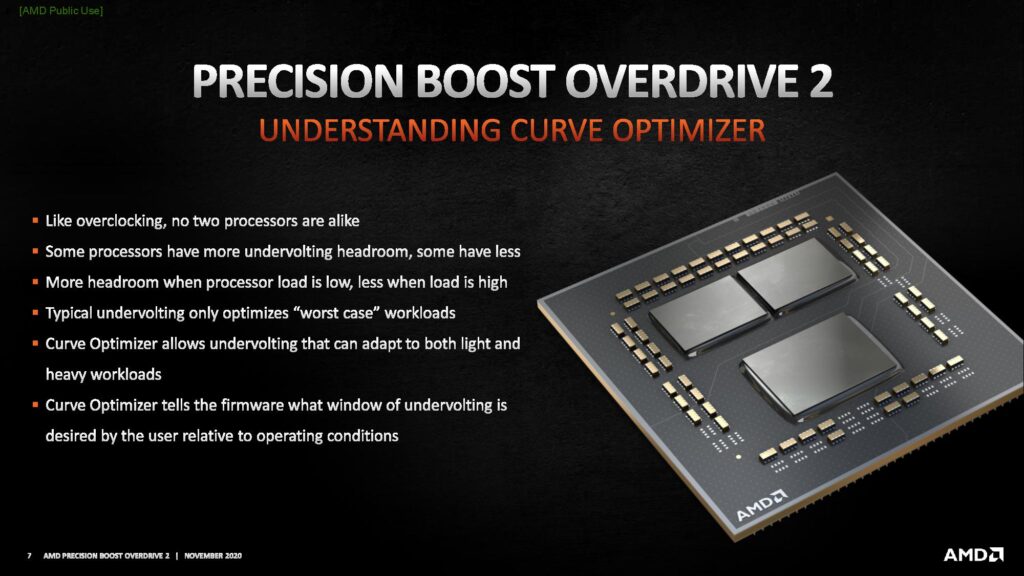
Curve Optimizer allows end-users to adjust the factory-fused VFT or voltage-frequency-temperature curve for each CPU core separately. The VFT curve is a unique curve for each core inside your CPU that defines the required voltage for a given frequency at a given temperature. Higher frequencies or higher operating temperatures require higher voltage.
Curve Optimizer adjusts the VFT curve by offsetting the voltages of the factory-fused VFT curve. By setting a positive offset, you increase the voltage point. Conversely, you decrease the voltage point by setting a negative offset. You can offset the entire curve by up to 30 steps in a positive direction and up to 300 in a negative direction. Each step represents approximately 5mV.
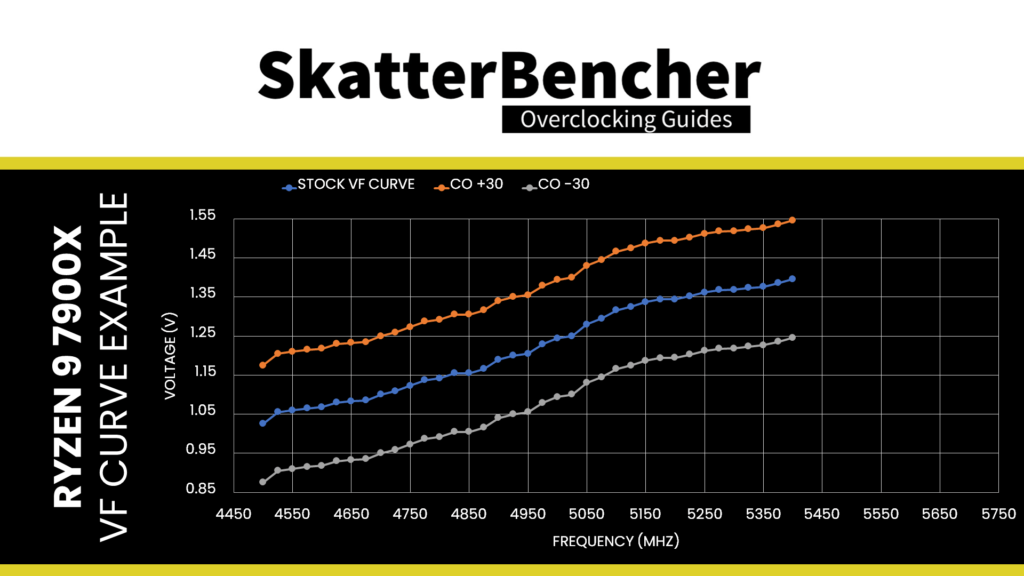
The traditional overclocking approach for AMD Ryzen CPUs is to set a negative curve optimizer. When you adjust the VFT curve with a negative point offset, two things happen.
- First, you tell the CPU that it needs less voltage for a given frequency. And, as a consequence, at a given voltage, it can apply a higher frequency.
- Second, the CPU temperature will be lower because you use less voltage at a given frequency. That extra thermal headroom will also encourage the Precision Boost algorithm to target higher voltages and frequencies.
In my AMD Raphael overclocking launch guide, I explored the ins and outs of Curve Optimizing with Precision Boost Overdrive 2. If you want to learn more about the impact of Curve Optimizer, I suggest you check out that guide.
As I mentioned already, Curve Optimizer is available on a per-core basis. Like in the past, per-core tuning offers a real benefit as it provides some cores with a lot more frequency headroom.
Curve Optimizer Tuning Process
The manual tuning process for Curve Optimizer can become quite convoluted since it affects the CPU core voltage in all scenarios ranging from very light single-threaded workloads to heavy all-core workloads.
My Curve Optimizer process for this Ryzen 9 7900X3D was as follows.
First, I use a broad tuning approach to get a big-picture understanding of the tuning opportunity. Then, I narrow the per-core curve optimizer settings to achieve stability in a light workload. Then, I verify the stability in all-core multi-threaded workloads. Lastly, I run through all my benchmarks to validate stability in a wide range of test scenarios.
The broad tuning process includes the following:
- Using SuperPI 32M with affinity to a specific thread to check the maximum effective clock frequency
- Gradually increasing an all-core negative curve optimizer until the point of instability
- Gradually increasing Fmax Boost Override in case the boost frequency is hitting the frequency ceiling
The narrow tuning process includes the following:
- Using CoreCycler to check the maximum effective clock frequency for each core
- Gradually increasing the per-core negative curve optimizer until the point of instability for each core
- Gradually increasing Fmax Boost Override in case the boost frequency is hitting the frequency ceiling
The all-core stability process includes running Prime 95 Small FFTs with both AVX enabled and disabled.
The benchmark validation process includes completing all the benchmarks I’ve included in this guide. If a benchmark is unstable, I increase every core’s per-core curve optimizer value by 2 until I reach stability.
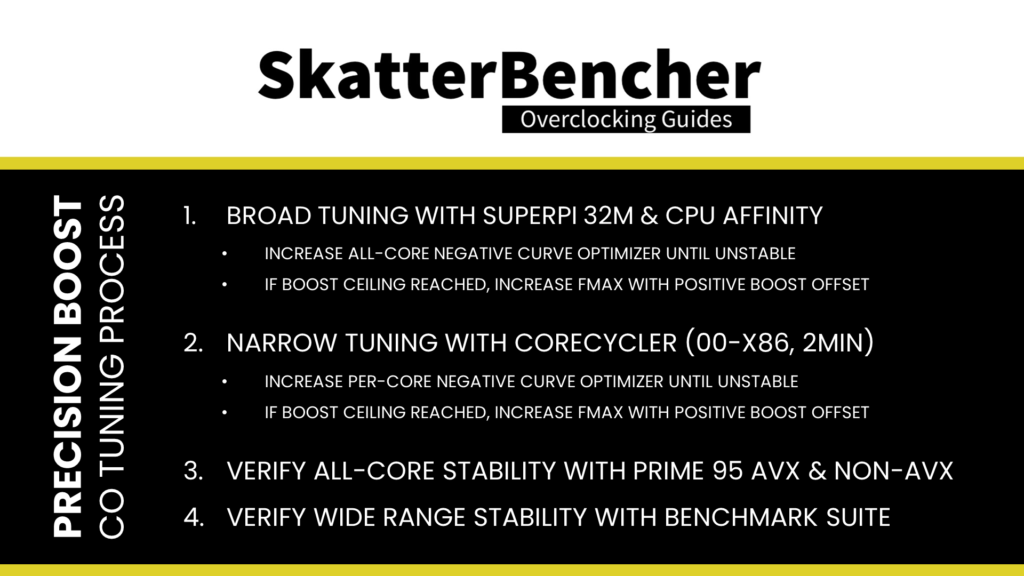
In my case, I used a per-core Curve Optimizer ranging from -45 for Core 9 to -5 for Cores 0 and 6 and a Fmax boost override of +150 MHz. The main limiting factor for my overclock is Prime95 Small FFTs stability with AVX2 enabled, which caused instability issues in single and multi-threaded applications with more aggressive Curve Optimizer and Fmax override settings.
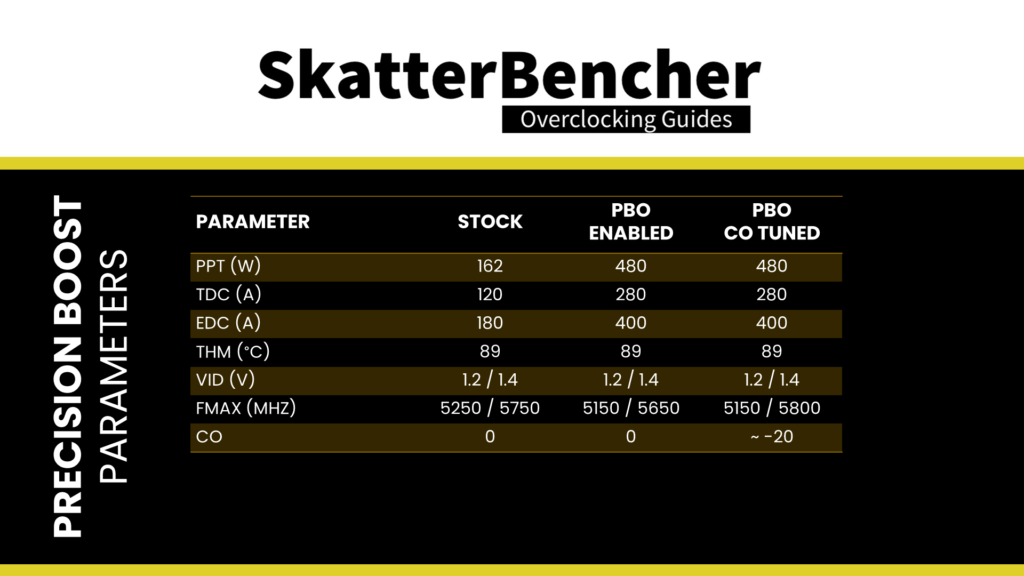
I will show you the BIOS configuration in a minute. But first, please note that the curve optimizer settings are CPU-specific, and the optimal values of your CPU may differ substantially.
The following table shows the boost profile for this specific CPU.
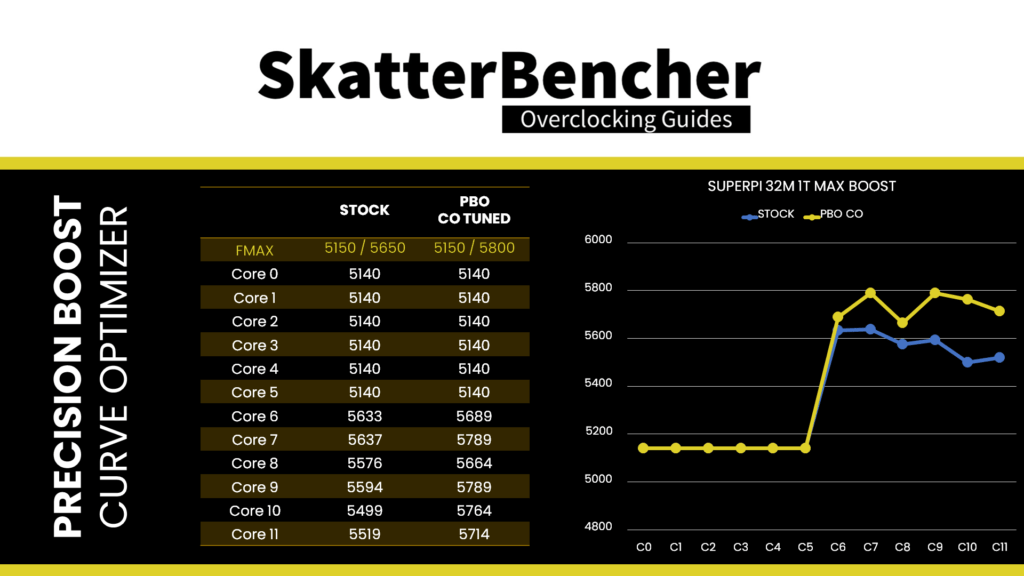
We can make a couple of interesting observations.
At stock, the boost curve shows a couple cores running higher than the advertised boost frequency of 5.6 GHz. That’s not unexpected, as we know the fused Fmax is 5.65 GHz, but it’s still nice to see some cores overdelivering on their promise. Furthermore, we can also see that all V-Cache cores run at their Fmax of 5150 MHz.
After Curve Optimizing, we see a substantial frequency uplift across the board. Two cores almost hit the new Fmax ceiling of 5.8 GHz. Unfortunately, we cannot do much more to push the V-Cache cores further as Fmax Override doesn’t apply, and the cores were already running at their Fmax at stock.
BIOS Settings & Benchmark Results
Upon entering the BIOS
- Switch to Advanced Mode
- Enter the Advanced CPU Settings sub-menu
- Enter the Precision Boost Overdrive sub-menu
- Set Precision Boost Overdrive to Advanced
- Set PBO Limits to Motherboard
- Set CPU Boost Clock Override to Enabled (Positive)
- Set Max CPU Boost Clock Override(+) to 150
- Enter the Curve Optimizer sub-menu
- Set Curve Optimizer to Per Core
- For every core, set Curve Optimizer Sign to Negative
- For Cores 0 and 6, set Curve Optimizer Magnitude to 5
- For Cores 1 and 3, set Curve Optimizer Magnitude to 15
- For Cores 2, 4, and 5, set Curve Optimizer Magnitude to 20
- For Cores 7 and 11, set Curve Optimizer Magnitude to 25
- For Core 8, set Curve Optimizer Magnitude to 10
- For Core 9, set Curve Optimizer Magnitude to 45
- For Core 10, set Curve Optimizer Magnitude to 35
- Leave the Curve Optimizer sub-menu
- Leave the Precision Boost Overdrive sub-menu
- Leave the Advanced CPU Settings sub-menu
- Set Extreme Memory Profile(XMP/EXPO) to EXPO 1
- Set System Memory Multiplier to 60.00
Then save and exit the BIOS.
We re-ran the benchmarks and checked the performance increase compared to the default operation.
- SuperPI 4M: +4.35%
- Geekbench 6 (single): +4.11%
- Geekbench 6 (multi): +8.97%
- Cinebench R23 Single: +0.84%
- Cinebench R23 Multi: +2.51%
- CPU-Z V17.01.64 Single: +0.18%
- CPU-Z V17.01.64 Multi: +3.32%
- V-Ray 5: +5.02%
- AI Benchmark: +8.49%
- 3DMark Night Raid: +2.59%
- CS:GO FPS Bench: +0.31%
- Tomb Raider: +0.00%
- Final Fantasy XV: +1.36%
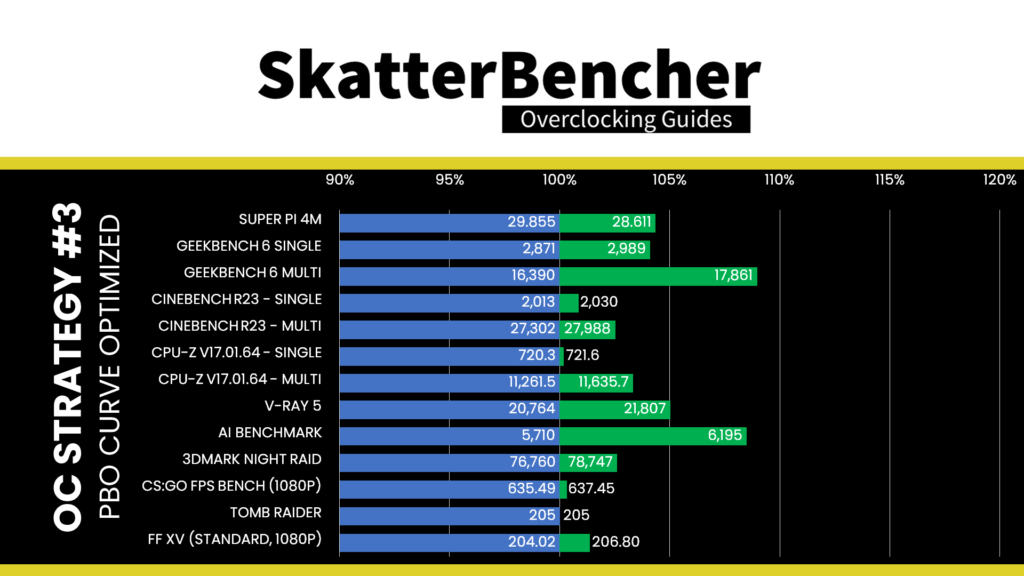
Here are the 3DMark CPU Profile scores
- CPU Profile 1 Thread: +1.52%
- CPU Profile 2 Threads: +2.69%
- CPU Profile 4 Threads: +2.61%
- CPU Profile 8 Threads: +2.63%
- CPU Profile 16 Threads: +4.08%
- CPU Profile Max Threads: +2.78%

While the performance uplift after Curve Optimizing is not earth-shattering, it’s nice to see we achieve better performance across the board. We see the highest performance improvement of +8.97% in AI Benchmark, and here and there, a slight performance improvement in single-threaded and light workloads.
When running Prime 95 Small FFTs with AVX-512 enabled, the average CPU effective clock is 4367 MHz with 0.929 volts. The average CPU temperature is 63.1 degrees Celsius. The ambient and water temperature is 25.7 and 30.9 degrees Celsius. The average CPU package power is 120.5 watts.

When running Prime 95 Small FFTs with AVX disabled, the average CPU effective clock is 4670 MHz with 0.991 volts. The average CPU temperature is 77.2 degrees Celsius. The ambient and water temperature is 25.8 and 31.1 degrees Celsius. The average CPU package power is 130.4 watts.
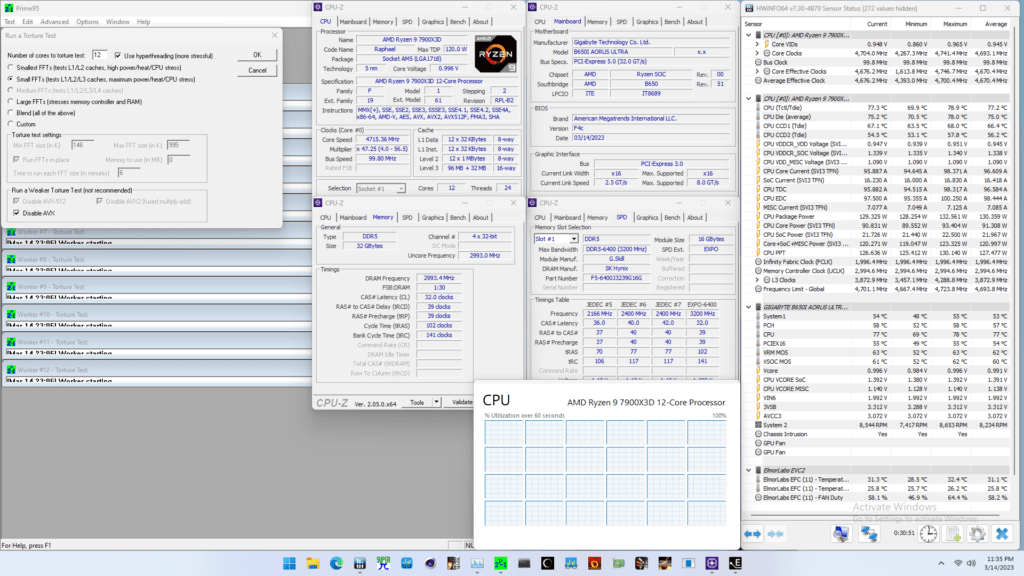
AMD Ryzen 9 7900X3D: Conclusion
All right, let us wrap this up.
By picking this specific CPU and motherboard combo, I wanted to experience what X3D overclocking feels like on a more mainstream motherboard. I call it mainstream because it’s a B650 chipset and doesn’t have support for asynchronous ECLK.
Overall, my experience was not fantastic. Clearly, the motherboard has no issue handling the 7900X3D. After all, the VRM temperature barely moves even under the toughest of workloads. The X3D’s overclocking limitations prevent us from squeezing more performance out of the chip. Aside from enabling EXPO and fine-tuning the per-core Curve Optimizer, there’s not much to tune.
That said, as an overclocking enthusiast who enjoys the pursuit of performance rather than obsesses about the performance gained, this was still a good experience and I did learn more about AMD Ryzen 7000X3D overclocking.
Anyway, that’s all for today! I want to thank my Patreon supporters for supporting my work. As usual, if you have any questions or comments, please drop them in the comment section below.
See you next time!
riu
i achieved 28870 points in cinebench after co per core, plus 200mhz boostclock and custom ddr5 timings
SkatterBencher #60: AMD Ryzen 7 7800X3D Overclocked to 5400 MHz - SkatterBencher
[…] already overclocked the Ryzen 9 7950X3D in SkatterBencher #56, the Ryzen 9 7900X3D in Skatterbencher #58, and the 5800X3D in SkatterBencher #39. The Ryzen 7 7800X3D is like the 5800X3D, a single-CCD […]
5 Minute Overclock: AMD Ryzen 9 7900X3D to 5789 MHz - 5 Minute Overclock
[…] I’ll speedrun you through the BIOS settings and provide some notes and tips along the way. Please note that this is for entertainment purposes only and not the whole picture. Please don’t outright copy these settings and apply them to your system. If you want to learn how to overclock this system, please check out the longer SkatterBencher article. […]